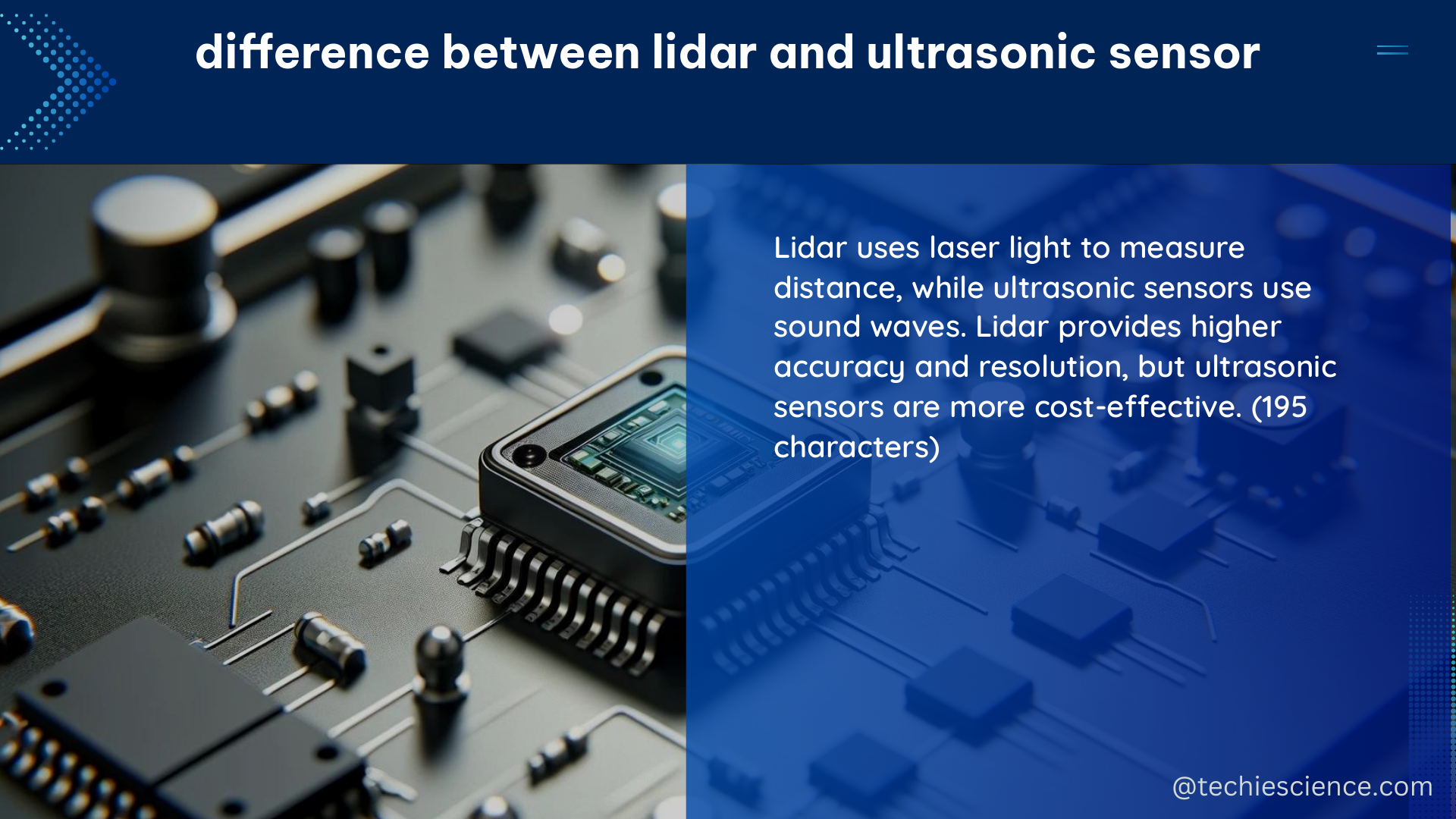Lidar (Light Detection and Ranging) and ultrasonic sensors are two distinct technologies used for distance measurement and object detection in various applications, including autonomous vehicles, robotics, and smart home systems. Understanding the key differences between these sensors is crucial for selecting the right solution for your specific needs.
Principle of Operation
Lidar Sensors:
– Lidar sensors use light, typically in the form of laser beams, to measure the distance to an object.
– The sensor emits a laser pulse and measures the time it takes for the light to reflect off the target and return to the sensor.
– By calculating the time-of-flight (ToF) of the laser pulse, the sensor can determine the distance to the object with high precision.
– Lidar sensors can provide detailed 3D point cloud data, which can be used to create a comprehensive map of the surrounding environment.
Ultrasonic Sensors:
– Ultrasonic sensors use high-frequency sound waves to measure the distance to an object.
– The sensor emits a sound pulse and measures the time it takes for the sound wave to bounce back from the target.
– By calculating the time-of-flight of the sound wave, the sensor can determine the distance to the object.
– Ultrasonic sensors are less affected by environmental factors, such as lighting conditions, compared to Lidar sensors.
Comparison of Key Specifications

| Specification | Lidar Sensor | Ultrasonic Sensor |
|---|---|---|
| Detection Range | Typically up to 100 meters or more | Typically up to 5-8 feet |
| Accuracy | High, with typical accuracy of 1-3 cm | Moderate, with typical accuracy of 1-2 inches |
| Resolution | High, providing detailed 3D point cloud data | Lower, with less detailed spatial information |
| Response Time | Fast, with typical response times in the millisecond range | Slower, with typical response times in the 10-100 millisecond range |
| Sensitivity to Environmental Factors | Can be affected by weather conditions, such as fog, rain, or snow | Less affected by environmental factors, such as lighting conditions |
| Cost | Generally more expensive than ultrasonic sensors | Less expensive than Lidar sensors |
| Power Consumption | Higher power consumption compared to ultrasonic sensors | Lower power consumption compared to Lidar sensors |
| Processing Requirements | Require more computational resources to process the 3D point cloud data | Require less computational resources compared to Lidar sensors |
Advantages and Limitations
Lidar Sensors:
– Advantages:
– Provide high-resolution, detailed 3D point cloud data
– Capable of detecting objects at longer ranges (up to 100 meters or more)
– Offer precise distance measurements with high accuracy
– Suitable for applications that require detailed environmental mapping and object detection
– Limitations:
– Generally more expensive than ultrasonic sensors
– Can be affected by adverse weather conditions, such as fog, rain, or snow
– Require more computational resources to process the 3D point cloud data
Ultrasonic Sensors:
– Advantages:
– Less expensive than Lidar sensors
– Less affected by environmental factors, such as lighting conditions
– Require less computational resources compared to Lidar sensors
– Suitable for applications that require cost-effective distance measurement and object detection
– Limitations:
– Shorter detection range (typically up to 5-8 feet)
– Lower accuracy and resolution compared to Lidar sensors
– Can be affected by the object’s surface texture, temperature, and humidity
Applications and Use Cases
Both Lidar and ultrasonic sensors have a wide range of applications, but their suitability depends on the specific requirements of the project.
Lidar Sensors:
– Autonomous vehicles and robotics: Lidar sensors are widely used in autonomous vehicles and robots for precise mapping, localization, and object detection.
– Surveying and mapping: Lidar sensors are used in surveying and mapping applications, such as topographic mapping, urban planning, and forestry.
– Security and surveillance: Lidar sensors can be used in security and surveillance systems for perimeter monitoring and intrusion detection.
– Industrial automation: Lidar sensors are used in industrial automation for precise measurement, quality control, and process optimization.
Ultrasonic Sensors:
– Proximity and distance measurement: Ultrasonic sensors are commonly used for proximity and distance measurement in various applications, such as parking assistance, object detection, and level sensing.
– Robotics and automation: Ultrasonic sensors are used in robotics and automation for obstacle avoidance, navigation, and material handling.
– Home automation and smart devices: Ultrasonic sensors are used in smart home devices, such as smart speakers and security systems, for gesture recognition and proximity detection.
– Industrial applications: Ultrasonic sensors are used in industrial applications for level measurement, flow monitoring, and material handling.
Conclusion
Lidar and ultrasonic sensors are both valuable tools in the world of sensing and measurement, but their differences in principle of operation, technical specifications, and applications make them suitable for different use cases. Understanding these differences is crucial for selecting the right sensor for your specific needs, whether it’s in the realm of autonomous vehicles, robotics, security, or industrial automation.
References:
- Federal Motor Vehicle Safety Standards; Rear Visibility. (2014). Retrieved from https://www.federalregister.gov/documents/2014/04/07/2014-07469/federal-motor-vehicle-safety-standards-rear-visibility
- Intelligent Systems Using Sensors and/or Machine Learning to Mitigate Wildlife-Vehicle Collisions. (2022). Retrieved from https://www.mdpi.com/1424-8220/22/7/2478
- Sensors for daily life: A review. (2021). Retrieved from https://www.sciencedirect.com/science/article/pii/S2666351121000425
- NUREG-1959 “Intrusion Detection Systems and Subsystems. (2011). Retrieved from https://www.nrc.gov/docs/ML1111/ML11112A009.pdf
- Sensing and Sensor Fundamentals. (2014). Retrieved from https://link.springer.com/chapter/10.1007/978-1-4302-6014-1_2

The lambdageeks.com Core SME Team is a group of experienced subject matter experts from diverse scientific and technical fields including Physics, Chemistry, Technology,Electronics & Electrical Engineering, Automotive, Mechanical Engineering. Our team collaborates to create high-quality, well-researched articles on a wide range of science and technology topics for the lambdageeks.com website.
All Our Senior SME are having more than 7 Years of experience in the respective fields . They are either Working Industry Professionals or assocaited With different Universities. Refer Our Authors Page to get to know About our Core SMEs.